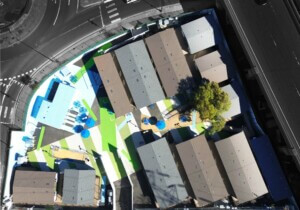A recent count by Los Angeles Homeless Services Authority (LAHSA) put the growing visibility and proliferation of homelessness in L.A. County into stark terms. Reporting a 5.7 percent increase in overall homelessness, the report counted 46,874 homeless individuals this year compared with the 44,359 counted in 2015. Within that statistic, LAHSA detailed 34,527 people living on the streets full-time, up from 31,025 doing so one year prior.
The count comes on the heels of L.A. Mayor Eric Garcetti’s as-yet-unfunded $138 million homelessness prevention and amelioration plan for fiscal year 2016, $86 million of which is earmarked for the development of permanent affordable housing like Michael Maltzan’s Star Apartments. Hoarse-voiced homeless advocates across the region hope LAHSA’s report might provide the political pressure needed to finally compel city, county, and state officials to act in a coordinated fashion on a phenomenon savaging a region already struggling with ever-increasing rents, neighborhood displacement, and across-the-board housing shortages.
Attempting to articulate the architectural community’s response to what it views as an increasingly important issue, the American Institute of Architects Los Angeles (AIA|LA) chapter convened a special congress bringing together design professionals, thought leaders, and local officials with the aim of developing “workable solutions” for addressing some of these housing affordability issues. The sold out, day-long congress, called Design for Dignity, also featured panel discussions and lectures from advocates working across the region to share best practices and new research.
The congress was notable for attempting to place the contributions of architects and designers front-and-center, both in addressing these crises and within professional discourse itself. AIA|LA’s Director of Government and Public Affairs Will Wright explained the conference’s primary goals to AN as wanting to “connect policy makers and housing providers to design thinkers; to underscore the role of the architect as an innovator that needs to be at the decision-making table as early as possible; and to set a compassionate tone of the fundamental importance of designing for all a dignified human experience.”
Long-time housing practitioners like Michael Lehrer, Michael Maltzan, and Lorcan O’Herlihy represented the design profession during various panel discussions held throughout the day, pressing for innovative and humane solutions. Regarding the architectural community’s role in addressing the homelessness crisis, Lehrer told AN, “Beauty is really a rudiment of human dignity, people who have nothing understand that and [they benefit from living in] places made with an open heart and with respect. [Architects] have to realize that the things that matter in architecture matter for everybody because they are human pleasures.”
Recently, the L.A. County’s population surpassed 10 million inhabitants and a corresponding and the Census Bureau reported a three percent vacancy rate in the Greater L.A. area (a Census-designated region including Long Beach and Anaheim) rental market. Therefore AIA|LA is right to spotlight architects’ potential role as innovators and leaders on this subject. Congress moderator Peter Zellner told AN, “Architects and designers have to become more involved politically if we are to raise awareness [on addressing the homelessness crisis in L.A.]. It would be incumbent upon architects to propose forms of urbanism that integrate approaches for housing the homeless and poor alike. We have to lead through design and articulate a viable, alternate vision for L.A. that is dense, vertical and integrated.”
With the abundance of homeless residents in the region expected only to grow over the coming years, it’s likely this phenomenon that will continue to grow, exacerbating and even deteriorating living conditions for all Angelenos if solutions advocated by the likes of Zellner are not more actively pursued across the city.
In fact, based on overall tenor of the day’s congress, it would be easy to argue that the future of architectural profession in the Southland is rooted in how design professions address the region’s combined homelessness and affordability crises. In a growing, densifying region, it’s likely that—along with sustainability and climate change—the issues of affordability and homelessness will play a major role in defining the careers of the young practitioners and students of today.
Congress attendee Kelly Majewski, principal at the recently-founded landscape architecture firm Superjacent, told AN, “Homelessness is an extremely complex problem that requires collaborative forward-thinking solutions between policy makers, space makers, and communities. The answer does not just lie in the building of new structures, but also in our approach to shared public space, be it our parks or our streets. As landscape architects and urbanists this is one of the biggest issues we are facing in the coming decades.”










